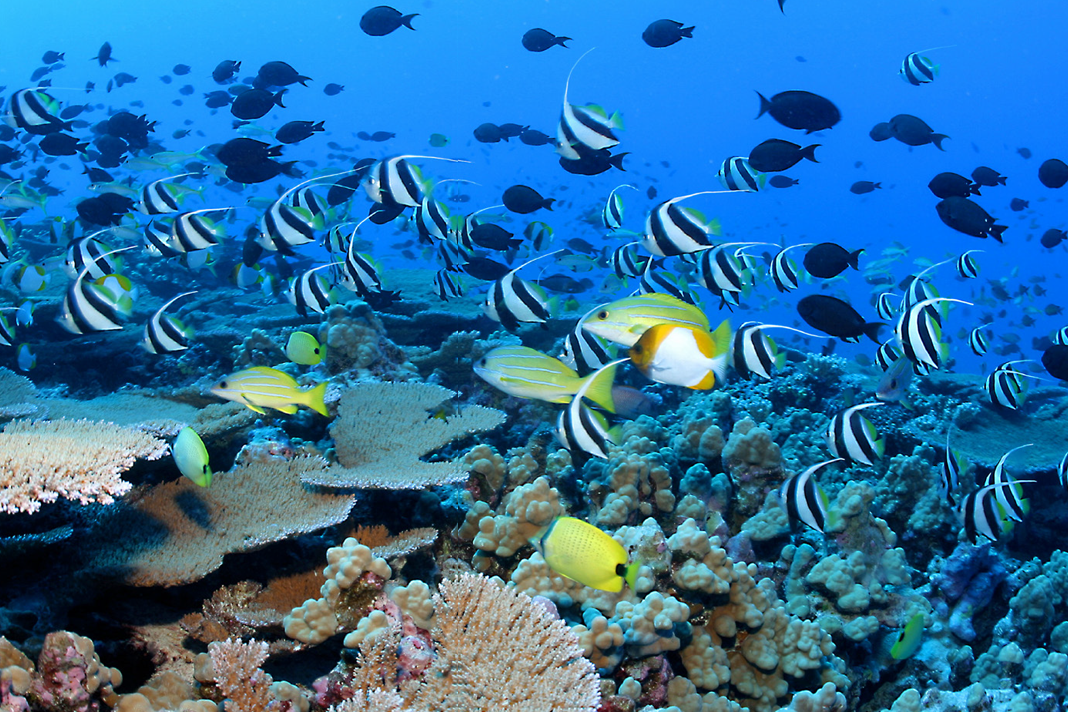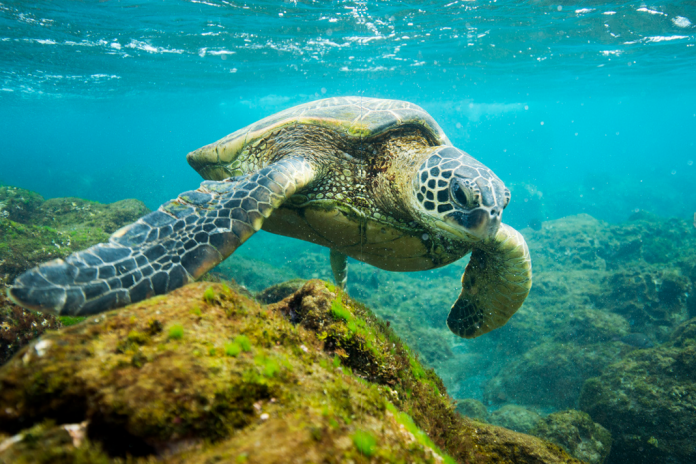On September 1, 2016, while 9,500 of the planets environmental advocates and international leaders were gathering in Honolulu for the World Conservation Congress, put on by the International Union for the Conservation of Nature (IUCN), President Barack Obama was on board Air Force One, flying to Kuaihelani, otherwise known by its English name, Midway Atoll. At just 2.4 square miles, this tiny piece of land played a key role in World War II history. Appropriately named, Mid-way Atoll lies roughly halfway between Asia and North America and, now, in the northwestern section of the largest protected sanctuary in the world. Which is why President Obama was heading that way. A week prior he had just announced the massive expansion of that area, Papahānaumokuākea Marine National Monument.
A publication put out by the Pew Charitable Trusts explains that, “Papahānaumokuākea is a place of honor, believed to be the root of native ancestral connections to the gods” It’s name means ‘a sacred area from which all life springs’.

That’s an accurate description for the marine reserve. More than 7,000 water creatures can be found here. A quarter of them exist nowhere else. The world’s oldest known living organism resides here – a 4,625-year-old black coral. New species continue to be found in the area too. Earlier this year, scientists discovered a ghostlike octopod nicknamed Casper. And while on the island, Time Magazine’s first ‘Hero for the Planet’ and National Geographic Explorer-in-Residence, Dr. Sylvia Earle presented President Obama with a photo of a newly discovered fish to be named after him.
“There’s cultural heritage underneath the water,” Nainoa Thompson, president of the Polynesian Voyaging Society explains about Papahānaumokuākea. “I dove every single island and I’ve seen them all underwater. I’ve been in places where there’s 400 sharks surrounding you. It’s intimidating but you are at the pinnacle of life amongst the apex predators and know that for that picture to take place this whole system needs to be protected.”
Originally created in 2006 by President George W. Bush, Papahānaumokuākea was also, at that time, the world’s largest marine reserve. His establishment of the monument inspired other countries to create large reserves as well. Since then, nine have been bigger than the original Papahānaumokuākea.
But this one is back to topping the list. The monument has now quadrupled in size to 582,000 square miles. Combine all of America’s National Parks and Papahānaumokuākea is still bigger. Texas can fit twice or California 3 and a half times within the reserve. Perhaps President Obama’s expan-sion of the area will also inspire other countries to step up their protected oceans. In a perfect world Papahānaumokuākea Marine National Monument will not remain the largest of it’s kind for long.
“More people know about ocean conservation today than they did a week ago because the president of the United States was standing in the middle of the world’s largest marine reserve…so I think it’s helping…achieve the next conservation victories for the ocean that will help make it more sustainable and more resilient to climate change,” says a hopeful Seth Horstmeyer, Pew Charitable Trusts’ Globe Ocean Legacy Director. But he warns that, “We are not finished with protecting the ocean. The science says 30% of the ocean needs to be protected. We’re at about 3%.”
US Senator Brian Schatz (D-Hawaii) agrees. “Expanding Papahānaumokuākea makes a definitive statement about Hawaii’s and the United States’ commitment to ocean conservation…President Obama’s declaration is only the beginning.”

Dan Laffoley, IUCN Principal Adviser on Marine Science and Conservation for the Global Marine and Polar Program, emphasizes that “93% of the enhanced greenhouse warming since the 1970s has gone into the ocean.” He continues, “If the same amount of energy that has gone into the top two kilometers of the ocean since the 70s had gone into the bottom 10 kilometers of the atmosphere, we’d have seen a warming of around 36 degrees centigrade. So the ocean has been shielding us, and the consequences of this are absolutely massive.”
That’s an increase of 96.8 degrees Fahrenheit to our air temperature if the ocean hadn’t been absorb-ing all the carbon and other harmful elements we’ve been spewing into our planet. Thankfully the seas have protected us from that, but it is causing irreparable damage. As the sea quickly warms, ecosystems are changing faster than the inhabitants of it can adapt. Coral is bleaching. Ice caps are melting. As sea levels rise, island life is threatened. Species are rapidly disappearing, never to be seen again.
Not addressing this issue is like biting the hand that feeds us. Or rather, it’s like gnashing on that hand till the skin, flesh, muscles, and bone are gone – till we’re chewing on our own tongues, trying to satiate the need for more – till the loss of blood by our own desire kills us. Because in this case, we’re not like dogs that can roam and scrounge for survival when the hand is no longer there to care for us. After all, we don’t get just get fed by this hand. We are sheltered by the hand. We breath by the hand. We live on the hand. As foolish as taking an axe (or bulldozer) to our own home while we are living in it sounds, that is exactly what we are doing on a daily basis. Acting on this issue is imperative because the harm of inaction is enough to end us.
But there is hope. The expansion of Papahānaumokuākea Marine National Monument proves that. While everyday Earth citizens may not have the political clout of a President or the knowledge of a scientist, they can still make a difference. When all the little steps that are taken – driving cleaner, recycling more, shopping smarter, living greener – are added up, they can easily have a far greater impact than any one protected area. The tens, hundreds, thousands, millions, billions of simple acts combined won’t just change our world. It’ll save it. And really, one of the biggest benefits of a place like Papahānaumokuākea is that it shows us what exactly it is we’re trying to save.
“It’s way more than a marine protected area, it’s way more than a national monument sanctuary. It’s a school. It’s a school that really reminds us of what the earth is supposed to be like.” -Nainoa Thompson-









